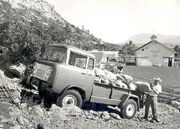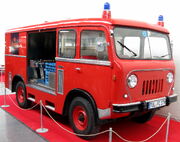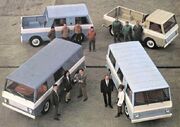 1958 Jeep FC-150 with stake bed 1958 Jeep FC-150 with stake bed | |
| Manufacturer | Jeep |
|---|---|
| Production | 1956–1967 |
| Layout | FR layout |
| Engine(s) | Hurricane F-head and L-head I-4 |
| Transmission(s) |
3-speed manual 4-speed manual |
| Wheelbase |
81 inches (2,057 mm) FC-150 108 inches (2,743 mm) FC-160 120 inches (3,048 mm) FC-170 DRW |
| Designer | Brooks Stevens |
The Jeep Forward Control is a truck that was produced by Willys and then Kaiser Jeep from 1956 to 1965. It was also assembled in other international markets. The layout featured a cab over (forward control) design.
Design[]
Willys produced utility vehicles that remained almost unchanged since 1947. As the marketplace grew more competitive in the 1950s, management developed a new range of modern cab and body trucks. Designer Brooks Stevens used styling cues from full-size cab-over-engine trucks. Engineering was based on existing CJ-5. Power came from the Hurricane F-head and L-head 4-cylinder engines.
The Forward Control models were primarily marketed as work vehicles for corporate, municipal, military, as well as civilian use. Regular pickup box beds were standard, but customers were offered a large number of "Jeep approved" specialized bodies from outside suppliers. These ranged from simple flatbeds to complete tow trucks, dump trucks, and fire trucks.
Proposals included a "Forward Control Commuter" design that may have been among the earliest minivan-type vehicles. Three operational concept cars were built by Reutter in Stuttgart, West Germany. Brooks Stevens was also involved in the transformation of this truck platform into a passenger vehicle.[1]
FC-150[]
Introduced in 1956, FC-150 models used the frame and wheelbase of the CJ-5 81 in (210 cm) with a 78 in (200 cm) bed. In 1958, the FC-150 received a new, wider chassis. Its track was widened from 48 in (120 cm) to 57 in (140 cm).

1957 Jeep model FC-170 with pickup cargo bed

Fire engine van body Forward Control
FC-170[]
Introduced in 1957, FC-170 models had a 103 in (260 cm) wheelbase with a 108 in (270 cm) bed. This was achieved by the forward-control layout.
FC-170 DRW[]
This is a 1 short ton (0.91 t) dual-wheeled rear axle (dually) model with a 120 in (300 cm) load bed. These models have gross weights of 8,000 lb (3,600 kg) or 9,000 lb (4,100 kg).
Production[]
The FC Jeeps were exhibited to Jeep dealers in a closed-circuit telecast on November 29, 1956, and were on display for the public at the December 1956 National Automobile Show in New York City. The FC-150 went on sale at dealer showrooms on December 12, 1956. The initial response to the four-wheel drive FC Jeeps was favorable. Their best sales year came in 1957, when 9,738 trucks were sold. After the introduction of the FC-170 in 1957, FC-150 sales dropped to 1,546 units in 1959, before rebounding to 4,925 in 1960. Neither model became the big seller that Willys had hoped. Total production in nine years was just over 30,000 units. The FC line was discontinued in 1964.[2]
Military variations[]
Aside from Forward Control Jeeps being built for civilian use there were also four models manufactured for the military.
- M676 - Basically a civilian FC with minor modifications
- M677 - A four door crew cab with a canopy over the bed
- M678 - An FC with a van body
- M679 - An M678 refitted as an ambulance
Non-USA models[]

c.1970s domestic market in India cowl & chassis FC-160
Numerous versions of FC models (most not available in the domestic market) were manufactured in many other nations under collaboration agreements with successive owners of Jeep: Willys-Overland, Kaiser Jeep, and American Motors (AMC).
India[]
Mahindra & Mahindra Limited in Bombay (Mumbai), India began its vehicle business in 1947 by assembling Complete knock down (CKD) Jeeps.[3] It started FC-150 production in India in 1965 and later expanded the model range for the domestic market to include the FC-170, as well as its own intermediate sized FC-160.
The FC-160 (and later FJ-160) uses a 93 in (240 cm) wheelbase. The pick-up box was by Mahindra and other bodies were available. The "cowl and chassis only" FC-160 model was popular during the 1970 s for conversion into mini-buses, ambulances, and other vehicles. Most have the basic front face of the FC. Manufacture of the Mahindra FC-160 pickup truck ended in the summer of 1999.
The FC-260 Diesel light truck was introduced in 1975. Currently, Mahindra's FJ-460 (introduced in 1983) and FJ-470 van or mini-bus vehicles retain the grille arrangement of the original Forward Control. These vehicles can accommodate from 11 to 15 passengers plus the driver.[4]
Spain[]

The Jeep "SV" line of Forward Control vans made in Spain. Note the panel version of the van and the crew cab of the pickup.
VIASA-JEEP Models
Vehiculos Industriales y Agricolas S.A. (VIASA) Cogullada Zaragoza Spain 1960s-1970s
VIASA Jeep, Zaragoza, Spain 1970s-1980s, To Date
VIASA JEEP Company History
In the 1960s, Kaiser-Willys licensed VIASA (Vehículos Industriales y Agrícolas, S.A.) to build Jeeps in Spain. During the late-1970s, VIASA was absorbed by Ebro trucks (a division of Motor Iberica). The "SV" line of commercial trucks were built using a Jeep chassis, just like the FC models in the USA. The unique Iberian models included the Campeador (one-ton pickup), Duplex (double cab pickup), Furgon (one-ton van), and the Toledo (9-seat van) and other models were launched. Two engines were available: the Super Hurricane in-line six or a Perkins 4-cylinder diesel but most were powered by Perkins tractor engines made in Spain.
The Beginning of VIASA Willys Jeeps were imported into Spain from the U.S. starting in 1953, and by 1960 the Spanish company VIASA ("Vehículos Industriales y Agrícolas, S.A.") was licenced by Kaiser-Willys to build a version of the CJ-3B in its factory at Zaragoza. The company name "CAF" appeared on the because VIASA was a division of parent company CAF ("Construcciones y Auxiliares de Ferrocariles") which built railway cars and locomotives.
After 1956, a factory at Zaragoza at the foot hills of the Pyrenees produced vehicles under licence from the American company Kaiser Jeep Corporation or KJC wellknown for making the famous WW2 Jeep MB 4X4 Series, however VIASA also manufactured after 1963 their own light 4X4 commercial vehicles with trambus bodies fitted in six different models. After 1974 the vehicles made by VIASA were also distributed and produced by Motor Iberica of Barcelona who renamed them EBRO-Jeep.
The vehicles were called Willys Viasa, and later, Jeep Viasa CJ-3. The first few were apparently built with the "Go-Devil" L-head gasoline engine and labelled as "MB-CJ3B", but most used diesel engines by Perkins and Barreiros. Other differences from the Willys CJ-3B included the gas tank on the right side on some diesel versions, conical (not flat) steering wheel, lighting control levers on the steering column and not on the dashboard, and no tool compartment under the seat. VIASA JEEP 4X4 Range
Around 1946, the semi deserted but mountainous and almost empty Iberian Peninsula needed a capable offroad vehicle to help with transportation of goods and people. Between 1963 and 1981, the Spanish VIASA company manufactured the Willys Jeep MB-CJ3 4X4 Series, at became available in the CJ-3B (short wheel base model) and the CJ.3B Long (long wheel base model) both models were powered by a Perkins P4D Diesel 3150cc 4 cylinder 60 bhp normally found in tractors. Alternatively another engine was the Barreiros Diesel 2200cc 51 bhp could also be fitted. By 1974 these machines were also being redeveloped and produced by EBRO Motor Iberica of Barcelona who made the same vehicles now with the new Perkins P4D 1760cc Diesel 57 bhp engine, all these engines were linked to a 3 speed automatic transmission or a manual 4 speed with all its gears synchronized and featured a 2 speed reduction gears with optional engageable front wheel axle drive, Both axles were rigged with 11 half-elliptic springs and there were drumbrakes on all four wheels.
The VIASA Jeep CJ3B or else called EBRO Bravo Jeep existed only in open metal body and a canvas roof, while the firts VIASA models appeared they could carry 2-4 passengers, the VIASA Jeep Bravo, the 2 seater only VIASA Jeep Bravo used as a pickup truck, the VIASA Jeep Bravo S with a wider range of equipment and the the VIASA Jeep Bravo Long that could take 2-8 people anywhere. In 1968 another factory owned by VIASA was opened in Cogullada near Zaragoza to manufacture the soon to be launched new VIASA JEEP SV 4X4 model range. Meanwhile Motor Iberica also sold these machines under the famous slogan: " There is Nothing It Cant Do". By the 1980s all Jeep CJ series production ended but then the new EBRO Patrol emerged another brand new concept model, that was also better known as the original Nissan Patrol 4WD.
The EBRO JEEP Comando and the VIASA WILLYS Jeep
In 1968, VIASA embarked on another franchise model of American design, that was to become known as the Jeepster Commando. It differed from the American original, being powered by a new Hurricane HUF4 petrol engine or else a new Barreiros C65 Diesel engine and later on an improved Perkins P6D 1800 Diesel 58 bhp or a 2300cc 66 bhp engine became available too. EBRO was also producing similar Jeep models but fitted them with standard more powerful Perkins P6D Diesel 2700cc 66 bhp and were rechristened as EBRO Jeep Comando HD, both these models the same concept, parts and most of the running gear to the more popular Jeep Bravo model.
Until the Spring of 1976, the standard Jeep Bravo , had been developed and distributed by VIASA and known as the Bella Bestia Commando, under the EBRO flag but very soon the spelling was changed into "Comando". While Motor Iberica kept production of their own EBRO Bravo Comando with most of the concept intact just improving its mechanicals gradually. Later on both models were called the Jeep Berlina a new 3 door station wagon, then came the Jeep Willys Cabriolet, a 3 door open body basic convertible jeep, and the standard EBRO Viasa Jeep that had a choice of closed model or a convertible model with canvas soft top roof.
THE VIASA JEEP SV 4X4 Series
Ealier in 1963 as mentioned above in the first part of this article, VIASA did produce their own light commercial model and it was a brand new concept, that was entirely and exclusively developed by Spanish engineers but inspired by the Jeep FC- Series based on some of its components and design. but fitted with 4WD axles and chassis and new suspension on all four corners. This later became known as the VIASA-JEEP SV Series, employing more powerful Perkins P4D 3150cc and P6D 3330 diesel engines with an old 3 speed manual transmission and later a new 5 speed gearbox with a reduction gear, optional front wheel drive axle and this new model was available until the early 1980s when production was over after more than 17 years being made. These commercial models had a top speed of 63 mph/ 120 kmh and were distributed and sold under several different names such as Jeep-AVIA, EBRO-Avia, VIASA-Jeep SV and AVIA-EBRO Jeep until around the Winter of 1983.
VIASA JEEP SV 4X4 Models
Camion- An AVIA designed crewcab truck with extended chassis, 6 seater model Perkins engine.
Campeador- A Viasa concept model that was a platform truck, with two doors and a 3 seater cab.
Duplex- A Viasa made 6 seater, 4 door van or a 5 seater truck with 1700 kilos of cargo it could carry.
Furgon- A Viasa designed 3 seater 2 door large van also most disguised as an Ambulance and Police vans.
Granjero- A Viasa developed chassis cab truck/ pick up truck with 2 doors and 3 seats popular with farmers.
Toledo- A Viasa produced, luxury van bodied machine/ Minibus, Tour bus, Camper with 3 doors and 9 seats
VIASA JEEP Present Day
Although this Zaragoza-based motorvehicle manufacturer, no longer produces any more of their own machines, it has been assembling and building most of Chrysler JEEP models, since 1982 from CKD (completely knocked down) from large kits arriving from the USA, At the VIASA, the firm has been geared up in this since the 1980s and has exported original American made current and modern JEEP to France, Italy, North Africa, Portugal and Spain, so if you find a JEEP Cherokee or JEEP Wrangler it was most likely to have been built by VIASA of Zaragoza. All the current and present JEEP models feature modern CRDI, CDTI and Petrol running gear and other updated engineering as similar to those JEEP models that have been made and under production today in the USA . The main slogan that triggered VIASA to relaunch JEEP once more in Europe in 1982 was "JEEP, There Is Only One."
References[]
| This page uses some content from Wikipedia. The original article was at Jeep Forward Control. The list of authors can be seen in the page history. As with Tractor & Construction Plant Wiki, the text of Wikipedia is available under the Creative Commons by Attribution License and/or GNU Free Documentation License. Please check page history for when the original article was copied to Wikia |
- Inline
- ↑ The Commuter, retrieved on October 30, 2007.[dead link]
- ↑ Dieffenbach, Mike. A Brief History of the Forward Control Trucks of the Late 20th Century, May 2002, retrieved on October 30, 2007.
- ↑ Official Mahindra history, retrieved on October 30, 2007.
- ↑ Forward Control 160?, retrieved on October 30, 2007.[dead link]
- General
- Auto Editors of Consumer Guide (2007–12–27). "1956 Kaiser-Jeep FC-150". howstuffworks.com. Retrieved on 2010–05–01.
- Foster, Patrick R. (June 2007), "S1957-65 Jeep Forward Control Trucks: Too Far Forward?", Collectible Automobile 24(1): 42–63.
External links[]
- The FC Connection, retrieved on September 14, 2010.
| Jeep road vehicle timeline, 1945–1970s — next » | |||||||||||||||||||||||||||||||||||
|---|---|---|---|---|---|---|---|---|---|---|---|---|---|---|---|---|---|---|---|---|---|---|---|---|---|---|---|---|---|---|---|---|---|---|---|
| Type | 1940s | 1950s | 1960s | 1970s | |||||||||||||||||||||||||||||||
| 5 | 6 | 7 | 8 | 9 | 0 | 1 | 2 | 3 | 4 | 5 | 6 | 7 | 8 | 9 | 0 | 1 | 2 | 3 | 4 | 5 | 6 | 7 | 8 | 9 | 0 | 1 | 2 | 3 | 4 | 5 | 6 | 7 | 8 | 9 | |
| Traditional | CJ-2A | CJ-3A | CJ-5 | ||||||||||||||||||||||||||||||||
| CJ-3B | CJ-7 | ||||||||||||||||||||||||||||||||||
| CJ-6 | |||||||||||||||||||||||||||||||||||
| Dispatcher | DJ-3A | DJ-5/6 | |||||||||||||||||||||||||||||||||
| Compact SUV | VJ | C101 | C104 | ||||||||||||||||||||||||||||||||
| SUV | Willys Jeep Wagon | Jeep Cherokee (SJ) | |||||||||||||||||||||||||||||||||
| Wagoneer SJ | |||||||||||||||||||||||||||||||||||
| Compact pickup | Commando | ||||||||||||||||||||||||||||||||||
| Full-size pickup | Willys Jeep Truck | ||||||||||||||||||||||||||||||||||
| Gladiator | Honcho/J10-20 Series | ||||||||||||||||||||||||||||||||||
| Truck | Forward Control | ||||||||||||||||||||||||||||||||||
| Van | FJ-3/3A | ||||||||||||||||||||||||||||||||||